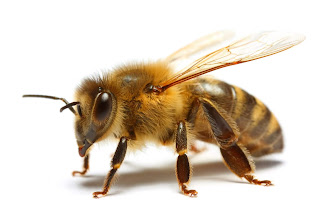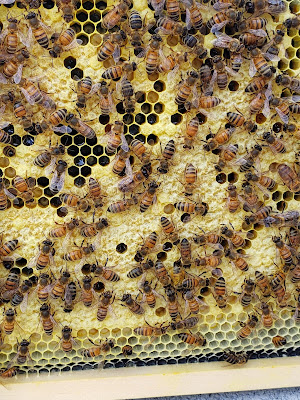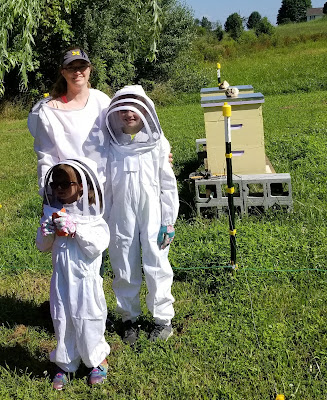Little bee sucks the blossom
Big bee gets the honey
I met Kerri Griffin when she was a bright-eyed, bushy-tailed young lawyer just starting out at my old law firm.
The partners who Kerri worked for – including me – had a high opinion of her work. She was even-tempered and easy to get along with, and her somewhat conventional exterior hid a very quirky sense of humor.
Kerri eventually moved on to another law firm, and then decided she had better things to do with her life than be a lawyer.
* * * * *
After having a baby about ten years ago, Kerri started a blog called “Naptime Huddle,” which combined NFL-related posts with recipes.
I contributed several guest posts to “Naptime Huddle” back in the day and Kerri returned the favor by writing guest posts for 2 or 3 lines. (You click here to read the “Naptime Huddle” post featuring my killer gazpacho recipe. And you can click here to read Kerri’s first 2 or 3 lines contribution.)
A few years ago, Kerri and her husband John packed up their son, daughter, and dog and moved to Culpeper, VA – which is about 70 miles southwest of downtown Washington, DC. Since moving, they added a second dog to their family – not to mention some 100,000 bees.
 |
| An Apis mellifera (or western honey bee) |
* * * * *
2 or 3 lines: Kerri, what made you decide to be a beekeeper?
Kerri: When John and I were planning our move out here, he kept bringing up the possibility of getting some kind of livestock – maybe chickens or goats . . . he seemed particularly interested in goats. Knowing I’d be the one doing most of the husbandry – especially the less glamorous work – I kept shooting down his suggestions. Then bees occurred to me – I already knew that they were really cool, and I thought it would be a different way to keep busy. Plus bees don’t take up much space, and they’re not messy. So I took a one-day introductory beekeeping class at a local bee supply store, and that hooked me.
2 or 3 lines: So bees are easier than goats?
Kerri: I have no idea – we never got any goats – but I will admit that I definitely underestimated the expense and the amount of labor required to keep bees.
2 or 3 lines: Have you harvested any honey yet?
Kerri: Generally speaking, you don’t harvest honey your first year. Your hives just can’t build up sufficient numbers to make enough honey that there is any extra for you to keep. Once you get past the “nectar flow” – that’s the time when nectar sources are blooming in the spring and early summer – your focus in late summer and through the fall is preparing the hives for winter. With the climate around here, each hive needs about 60 pounds of honey to get through winter and into early spring, when things start to bloom again.
2 or 3 lines: Once a hive is built up, how do you actually harvest the extra honey?
 |
Kerri: The bees live in two boxes. Picture a two-drawer file cabinet – the frames that they build honeycomb on are like hanging files. If the bees are able to fill up all of the frames in those two boxes during the buildup of the hive in spring, then you can add a honey “super,” which is a box that is about half the depth of the other boxes. Any honey that is stored in that is what you can keep. If you’re lucky, you might harvest two or more of these boxes from one hive in one season.
2 or 3 lines: Is it complicated to harvest honey?
Kerri: That depends on how you want your honey. If you’re looking to harvest comb honey, you simply carve out a slice of honeycomb and put it in a jar. But most people want plain honey. Extracting honey from the comb is not exactly simple. Once the bees have created honey, they cap the cells of honeycomb with wax. So the first thing you have to do is to remove these cappings. There are many tools you can use, from a simple scraping fork to heated electric knives. Then you place the honeycomb into a honey extractor, which spins the honey out of the comb using centrifugal force. The simplest (and cheapest) extractors only hold three or four frames of honeycomb and are manually cranked. Top-of-the-line extractors can hold more frames and have powerful motors to spin them. When the combs are drained, the honey goes into a bucket, which has a strainer on top. The bucket has a spigot at the bottom, so the honey goes from there into bottles or jars.
2 or 3 lines: So how did things go for you in your first season?
Kerri: One of my hives filled about half of a super by the end of summer, but I kept that honey to make sure I had enough feed the bees early this spring. I really have no idea how much honey I might end up with this year. My first batch will go to friends and family, but I would very much like to sell honey at a farmer’s market at some point. We also have some prolific blueberry bushes, so maybe I’ll sell some berries as well.
2 and 3 lines: When you and I worked together, we spent a lot of our time evaluating health claims for foods, drugs, and dietary supplements that our clients wanted to make in their advertising. There are a lot of health claims for honey and especially royal jelly, which is the honeybee secretion that is fed to queens. Do you buy all those claims?
Kerri: The basic nutritional value of honey is not much in dispute – it has been consumed for thousands of years as a sweetener, and a lot of people believe it has health benefits. I’m unclear about what specific health benefits have been substantiated by research, but I know the federal government has challenged advertising claims for royal jelly in particular. Honey definitely has one unique property: since bacteria can’t survive in honey, it never spoils. You may have had old honey crystallize, but it’s safe to eat – just heat it up a little to get rid of the crystals.
2 or 3 lines: I think I’d have a hard time getting over my fear of being stung. How afraid were you when you were getting started? Are you completely comfortable with your bees now?
Kerri: I absolutely had fear at the beginning. Before my first several interactions with them – picking up the packages of bees and installing them in the hive, and my first few inspections – I had butterflies and not just a little anxiety. But eventually I was able to relax. You have to be quite focused on the task at hand as you’re working with them – you have to push other thoughts aside. Holding a frame covered with over a thousand bees puts you a little bit in awe of yourself, and you get a little more confidence after every trip to the apiary. Stings are no fun – and I’ve been stung a few times – but it’s kind of like a rookie quarterback getting hit hard at the start of an NFL game. Once you know what to expect, you don’t dread it as much.
 |
Kerri: There are a variety of protective items you can wear, depending on your level of confidence: a hat with a veil, a heavy jacket and pants, thick gloves – some people don’t wear gloves, or just go with thin nitrile gloves. There’s even a one-piece garment that has everything except the gloves – essentially long-sleeved coveralls with a netted head covering attached. In the high heat of summer, you can easily get heatstroke if you aren’t well hydrated, so I’ve heard that people who like those coveralls wear only their underwear or a bathing suit under them. Personally I wear a wide-brimmed hat with veil attached, a pullover jacket made of fairly thin material, a long-sleeved shirt under the jacket – because I have been stung through my jacket – my thickest pair of jeans (which I now only wear for this purpose), and rain boots that I can tuck my jeans into.
* * * * *
The next 2 or 3 lines will feature an essay Kerri wrote about queen bees. I guarantee you that it’s going to make you want to know even more about honeybees.
My thanks to her for all the time she put into writing that essay – which will include some fascinating photos and videos of honeybees in action – not to mention the time she spent answering all my questions today.
* * * * *
Bob Wills, who formed the Texas Playboys in 1934, essentially invented the “Western swing” music genre. He’s one of the very few people to have been inducted into both the Country Music Hall of Fame and the Rock and Roll Hall of Fame.
 |
| Bob Wills |
Click here to listen to “Take Me Back to Tulsa,” which was a big hit for the Texas Playboys in 1941.
Click on the link below to buy the song from Amazon:
